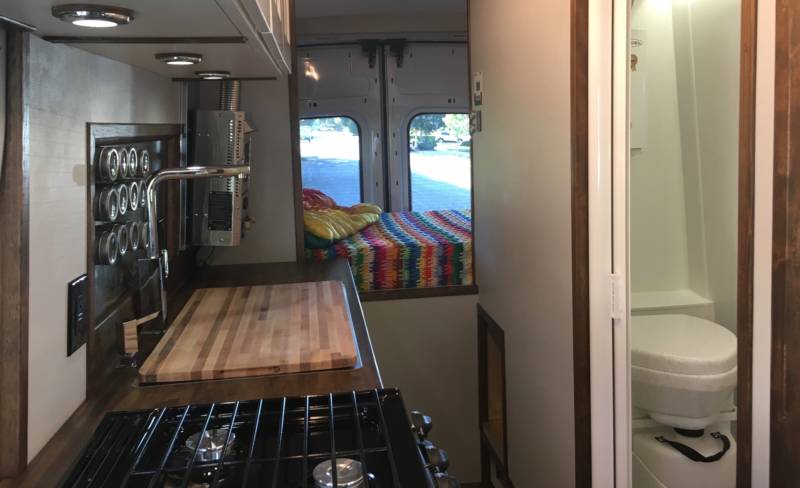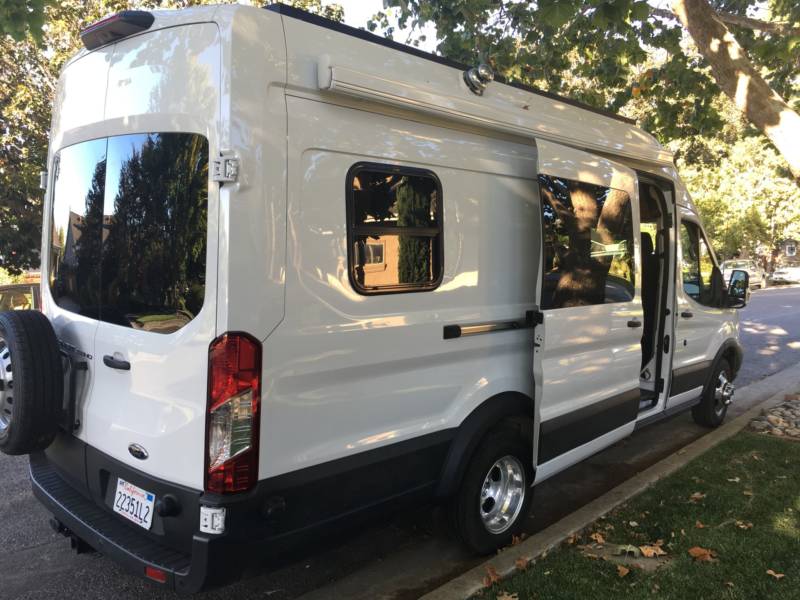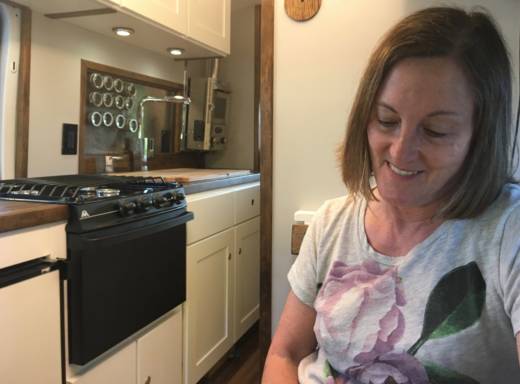At 61, Mercury News reporter Tracey Kaplan of San Jose did not see how it would be possible for her to buy a home in time for her to retire locally. Naturally, she wrote about this dilemma for her newspaper:
The median price of a Bay Area home keeps getting further and further out of reach for many. At $920,000, it’s already more than double what it was six years ago. And with average rents for a one bedroom in San Jose clocking in at $2,266 a month, a growing number of people seem to be turning to alternative housing on wheels, from RVs and tiny houses on flatbed trailers, to school buses, trucks, vans and even converted ambulances.
In this crazy real estate market, an increasing number of people are taking to living in their vehicles, even if they’re working.
So it was that Kaplan decided to raid her 401K to build a studio apartment on wheels and make herself the story, in a good way. She files stories on her process. She shares on Instagram with the account @itsavanlife.
Now, after months of chronicling her process from dream to reality, Kaplan reported herself on the happy day her fully customized, special-order Ford Transit 350 arrived outside her home.
“It’s a 22-foot-long cargo van that’s been converted into a mobile home, effectively, and where I’ll be living when I retire,” she says with genuine enthusiasm.
Not as far-fetched as you might think
Kaplan was a child when she heard about Ken Kesey and his Merry Pranksters driving cross-country in a psychedelic painted old school bus back in the 1960s.
That’s when the idea was planted in Kaplan’s brain that living a peripatetic life on the road might be more fun than trying to squeak by, aging in some horrendously expensive conventional housing situation. That’s not an irrational fear, given the trend lines for rentals in the San Francisco Bay Area.
“As I approached retirement, I started worrying about where I was going to live as a single woman on what’s going to be an extremely limited income of under $3,000 a month — which sounds like a lot — but not around here, right?” says Kaplan, who doesn’t want to move out of the Bay Area.
How have her friends reacted?
“People are excited for me,” Kaplan says, before adding, “Some people — without naming names — thought I was insane. Certainly, financially, I just did a desperate thing. But what was I going to do? I can’t work forever.”

After 31 years of steady work and saving, Kaplan had the wherewithal to buy a brand-new van. Her research led her to settle on a special-order Ford Transit 350 with an extra set of wheels “for stability,” as well as a high roof and extended length, “so I can stand up, and walk in it, and live in it.”
This van also has sliding doors on both sides, “to create a breezeway,” and the driver and passenger seats swivel, so up to three people can sit comfortably while waiting for one of her home-cooked meals. “It’s almost like a little living room.”
The gas mileage isn’t great, just 15 miles per gallon. But Kaplan doesn’t expect to be driving around much. She figures she’ll travel to spots where she wants to stay awhile.
Not being mechanically minded, Kaplan hired Kyle and Josh Volkman to convert the van into a home. “We just had a phone conversation, and it went from there.”
They tore out the insides and put in a bed, shower, toilet and a kitchen fit for a foodie — all of it built to last as long as she does. “I mean, look around. It’s fantastic, right?”
Altogether, including roughly $15,000 for labor and $22,000 for parts, Kaplan figures she’s spent about $90,000 on her retirement home. That’s more than some people would spend on something like this, but Kaplan says she spared no expense because she anticipates living another 30 years.

About the color
Kaplan did think about going in a more colorful direction, but then she started asking around for advice, and experts talked her down.
“I really wanted to go psychedelic, and if you come back in a couple of years, it might look that way,” she says. “I even hired an artist out of the Pacific Northwest to advise me.” The artist told Kaplan crazy colors would likely drive her crazy inside such a small space.
It’s also a major plus that this van is less obtrusive than a psychedelic school bus or dilapidated RV might be on a residential street. As more people take to living in their vehicles, more people are complaining to civic authorities in hopes of pushing transient neighbors out.
“I’m keenly aware that a lot of people are forced into the lifestyle,” she says, adding she plans to volunteer at the Rubber Tramp Rendezvous, an annual get-together organized by a veteran van lifer named Bob Wells, who runs a website called Cheap RV Living.
Essentially, she’s plugged into a vast network of people who help each other out.
Kaplan may be a single woman, but she doesn’t plan to sit inside her van and mope through retirement.
“The whole point is to get out of the house and meet people. In coffee shops and parks and, you know, texting with van lifers and meeting up with them,” she says.

